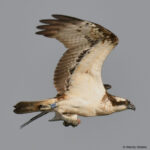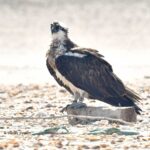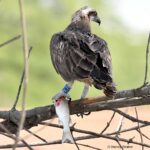Once again this year the females (at least those that we know about) released by Nos Oiseaux have “out-bred” the males of the project. Dominique Lorentz has told us that Mouche (PR4) and her partner AM06 have fledged two young in the French Department of Moselle – the fifth successful breeding of this pair. Pistache (F11), rediscovered for the first time since she was released in Switzerland in 2018, paired with an unringed male and fledged two young (photo above) in the French Department of Marne, as reported by Julien Rougé. This was particularly reassuring news, the nest being on top of a rather dangerous type of medium-voltage electricity pylon, stressing nearly everyone – except apparently the birds themselves.
In the German Province of Baden-Wurttemberg, Chronos (ex-PS9) and her partner (named Kepler last year), sadly failed this season. After two years of successful breeding, Chronos incubated long past the time when her eggs should have hatched. Daniel Schmidt thinks that the most likely cause might be damage to the eggs by pine marten Martes martes, although due to a technical problem with the camera-trap, the reason for the failure will remain unknown.
As for the females in Switzerland, 2025 has been exciting since two unringed immatures around 2-3 years old spent much of the summer with two territorial males in the Three-Lakes region, Olympe (F28) and Racine (F29). In both cases, intense courtship, mating and nest-building activity was observed, generating high hopes for 2026… provided of course that all return safely from migration next spring. Arthur (F12), our most famous male, has continued to be on the lookout for a passing female, using the two platforms installed for him at Hagneck and – as in past years – also building at least one additional nest by himself.
Migration has now started, the two summering females have already left, and we continue to keep a close eye on “our” males until they head south in the coming 2-3 weeks.























